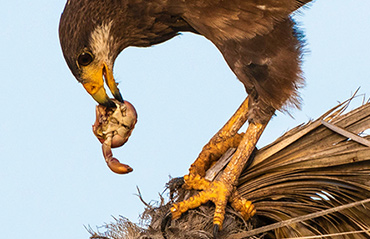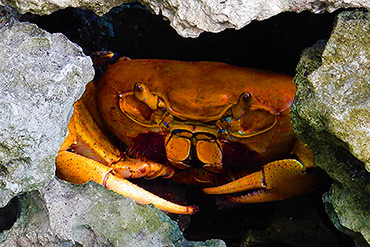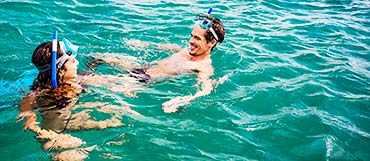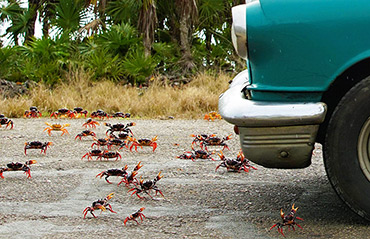Havana jazz fest plus review
The Jazz Festival was phenomenal, the people very gracious and friendly, and the culture fascinating. I absolutely loved Cuba and look forward to a return trip. This trip ... Full review
Ruth Michelson
Placerville, California
Havana jazz fest plus review
My husband and I enjoyed our trip to Cuba very much especially because it reminded us of Puerto Rico where we were born. The architecture, the history, the ... Full review
Noemi Figueroa
Lutz, Florida
Just the jazz festival review
The Havana Jazz festival was wonderful. I thoroughly enjoyed every venue that we caught. Cubans are wonderful, kind, fun, warm and gracious people despite the very considerable difficulties ... Full review
Elliott Blass
Newton Center, Massachusetts
Havana jazz fest plus review
I was impressed with the people of Cuba as well as the culture. I observed that the culture of music, as well as art and dance, flows through ... Full review
Michael Innis
Far Rockaway, New York
Just the jazz festival review
Under adverse conditions the culture and people have remained resilient and retained their identity. Music, food, outlook on life is very positive. Everyone was pleasant, helpful and eager ... Full review
Valerie Moss Washington
Bronx, New York
Havana jazz fest plus review
I love Cuba. The people. I really liked the breakfast manager at the hotel Habana Libre. His customer service was EXCELLENT! Thought the overall food quality could have ... Full review
Diane Smith
San Francisco, California
Just the jazz festival review
My family and I thoroughly enjoyed our Cuban vacation. Everyone was so friendly and hospitable. Our tour guide, Marianna, was exceptional, and our driver, Ray, made sure we ... Full review
Claudia Haines
Columbus, Georgia
Just the jazz festival review
The people, entertainment and history of the island exceeded our expectations. The music was the best! Our tour guide was exceptional in providing help with the different venues ... Full review
Carlos Vargas
Bronx, New York
Havana jazz fest plus review
We felt very safe in Cuba. There was so much to learn. We'll certainly return. We were very impressed with the Cuban people and their culture and friendliness. ... Full review
Farrokh Mahmoudi
Encinitas, California
Just the jazz festival review
Loved the people, food, and the music, but went for the Havana Jazz Festival. Would have liked to have spent more time in Afro-Cuban cultural environment. Definitely a ... Full review
Russell Jackson
Houston, Texas
Havana jazz fest plus review
Very friendly people. Many people live in poverty, but don't seem to blame the US for it, even though decades of sanctions has taken a severe toll. Can't ... Full review
Jim Smith
Key West, Florida
Havana jazz fest plus review
I want to return one day. I am deeply impressed with the spirit of this generation of Cubans. They are making the best of their homeland. I am ... Full review
M Frances Manning-Fontaine
Palm Coast, Florida
Havana jazz fest plus review
Friendly and optimistic, hardworking, very eager to please tourists and earn money. I liked the jazz concerts and most of the organized excursions: the organic farm, Fuster's mosaic ... Full review
Steven Guberman
St. Paul, Minnesota
Havana jazz fest plus review
I was very impressed with my travel to Cuba. So impressed I will be returning in July or September. The people were very engaging and always willing to ... Full review
Dessie Andrews
Tallahassee, Florida
Havana jazz fest plus review
My impressions were very positive. The warmth and kindness of every person I came in contact with was very positive. The culture was very welcoming and non-judgemental. Loved ... Full review
Kenneth Fullmore
Rio Vista, California
Just the jazz festival review
The itinerary was just perfect, filled with a cultural, historical and social understanding of Cuba. Plenty of free time for the phenomenal Jazz Festival. Jazz Plaza 2019 was amazing. ... Full review
Julie Hagigeorges
Winthrop, Massachusetts
Havana jazz fest plus review
Personally I loved Cuba and the people and their unity. My tour guide Laura was very professional and down to earth I can't say enoughabout her, she was ... Full review
Rodney Smith
Los Angeles, California
Havana jazz fest plus review
It was beyond my expectations. I absolutely loved visiting Cuba. I enjoyed the history, the architecture, the people, the culture, the natural beauty, the arts, and of course, ... Full review
Nancy Chiesa
San Francisco, California
Havana jazz fest plus review
Very impressive trip. I loved touring modern Havana and old colonial city, the mojitos, charming natives. A bit expensive when compared to other Caribbean counties, but I find ... Full review
Niurka Gonzalez
Forest Hills, New York
Havana jazz fest plus review
The people and culture are vibrant and lively. Our local guides were informative, charming, funny. I wish I could have seen it in its prime. The beautiful architecture ... Full review
Valerie Schwartz
L.a., California
Just the jazz festival review
The people we met were warm and welcoming. We were blown away by the music and art. Everything was fabulous! I really appreciated the small group size and ... Full review
Gael O'Sullivan
Bethesda, Maryland
Havana jazz fest plus review
Beautiful country, friendly and funny and warm people. The Havana jazz fest plus tour was very educating and interesting.
Olufemi David Oladehin
Calgary, Ab
Just the jazz festival review
Friendly and welcoming. I appreciated seeing the pros and cons of socialism. The structure of the itinerary was perfectly paced for mornings and afternoons, and then evening music ... Full review
Robert Kiefner
Concord, New Hampshire
Just the jazz festival review
Amazing experience of immersion in the Cuban culture and the Cuban people. I loved everything! Our guide, Claudia was superb. The historical architecture of the hotel was amazing. ... Full review
Susan Cauthon
Denver, Colorado
Havana jazz fest plus review
The Cuban people are the friendliest people of all the people my wife and I have met in the various countries we have traveled to including most of ... Full review
Robert Pokress
Andover, Massachusetts
Just the jazz festival review
Beautiful people, all very kind and welcoming. Our tour guide Mariana and our bus driver were outstanding.
Vinod Khilnani
Gulfport, Florida
Havana jazz fest plus review
Very impressed with every aspect of Havana, and the Jazz Festival. Loved the historical information provided by our tour guide Norberto.
Robert Clark
Philadelphia, Pennsylvania
Just the jazz festival review
I loved the music, found it amazing there are so many fabulous musicians. Was also impressed with the arts and thought people were very friendly and gracious. Great ... Full review
Olga Pomar
Camden, New Jersey
Just the jazz festival review
What a fantastic introduction to Cuba, its people, culture, history, music, and more? The excellent tour itinerary offered a variety of activities and inside views of aspects of ... Full review
Peggy Gennatiempo
Bellevue, Washington
Havana jazz fest plus review
Loved the Havana Jazz Festival and our trip to Las Terrazas. Cubans are clearly proud of their island and culture. People were friendly and eager to help.
Marilyn Arp
Mccall, Idaho
Just the jazz festival review
Cuba is a wonderful place to visit and enjoy its rich and diverse culture. Everyone was friendly and we were impressed by the many talents they possessed. Cuba ... Full review
Walter Reed
Missouri City, Texas
Just the jazz festival review
The country was fascinating, the people were friendly and helpful, and the culture has similarities to other countries of Hispanic origin. Our tour guide Linett was excellent. She ... Full review
Daniel Diaz
San Antonio, Texas
Havana jazz fest plus review
I have become an envoy to pass the message to many about your beautiful country! Your informative guides were a highlight.
Heyward Johnson
Kenner, Louisiana
Havana jazz fest plus review
The tour could not have been better organized. You gave us more to see and to learn about Cuba than we ever expected! Thank you! The tour could ... Full review
Siegfried Gerstung
Baltimore, Maryland
Havana jazz fest plus review
I couldn't have been more impressed by the Cuban people and their culture. The well organized Jazz Festival venues were the highlight. Indeed the whole trip experience was ... Full review
Sol Wald
Boynton Beach, Florida
Havana jazz fest plus review
The Havana Jazz Festival! Everything here exceeded expectations: music, art, food and how nice everyone was.
Kevin Costa
New York, New York
Havana jazz fest plus review
This was my third trip to Cuba. As with previous trips, I thoroughly enjoyed the country and its people. Especially the music. The tour was well planned and ... Full review
Keith Hill
Waggaman, Louisiana
Havana jazz fest plus review
Very interesting history and culture! A great mix of people, music, religion, architecture and vehicles for transportation! The tour was well organized by the tour leaders and of ... Full review
Eivind Lande
Oslo, Norway
Just the jazz festival review
We went to the amazing Havana Jazz Festival! My Latina partner and I love the music of Latin America. This is the largest event in the world for ... Full review
Bruce Smith
Sacramento, California
Just the jazz festival review
Music everywhere was so much fun. I learned a great deal and had fun while learning. The ballet school was so heartwarming and special. I had a great ... Full review
Daphne Moss
Yonkers, New York
Havana jazz fest plus review
Amazing extraordinary culture, unparalleled arts, music, dance, fine arts and beautiful family centric people. Cuba's the poorest richest country we have ever visited! Infrastructure in disrepair, lack of ... Full review
Michael Wymes
Berkeley, California
Havana jazz fest plus review
I loved the opportunity to visit Cuba and learn more about its history and culture. I enjoyed interacting with the Cuban people, who were very friendly and welcoming. ... Full review
David Kinzler
Bloomington, Indiana
Just the jazz festival review
I loved meeting the Cubans we encountered. They were gracious, generous, helpful, and shared our fun-loving nature. I also adored the sense of quality music and art being ... Full review
Bart Schneider
Berkeley, California
Havana jazz fest plus review
My company, African Venture Inc., has hosted four previous tours to Cuba. We travel by road from Santiago to Camaguey, Trinidad de Cuba, Cienfuegos, Perico, and Havana. One ... Full review
Marlene Melton
New York, New York
Havana jazz fest plus review
What an incredible holiday. The best I have had! My impressions of Havana and the places we visited during the Cuba Jazz tour are all positive. I thoroughly ... Full review
Deborah Gunter
Kew, Undefined
Havana jazz fest plus review
The music was excellent. The people of Havana are lovely, warm, and friendly, and a great collective soul. I wish they had more money to lead a more ... Full review
Deborah Weldon
Vancouver, Bc
Havana jazz fest plus review
We'll be back. We fell in love with Havana! Great music everywhere you went. The people we met were very friendly, and the hotel Meliá Cohiba was tremendous ... Full review
Charles Washington
Wickenburg, Arizona
Just the jazz festival review
It was an incredible trip. The music, the people, the architecture, the Museums. I felt welcomed by Cuban's. Our guide, Linette Brown, made all the difference. She was ... Full review
Margaret Suits
Great Falls, Montana
Havana jazz fest plus review
Loved the tour and the opportunity to get to know Cuba and experience the stellar Havana Jazz Festival. Our daily schedule went smoothly. All the activities began and ... Full review
Sara August
St. Petersburg, Florida
Havana jazz fest plus review
What I liked best were the tours through places I would never have found on my own going to the countryside and seeing the artistry was excellent. The ... Full review
Carmen Monedero
Foster City, California






